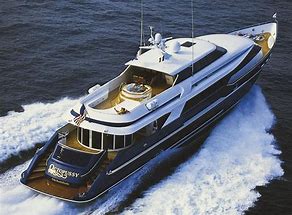When American entrepreneur, John Staluppi, decided in the early 1980s that he wanted the fastest superyacht in the world – one that could break the 50 knot (57.5mph) barrier – every boatyard told him it couldn’t be done. Every boatyard except Heesen Yachts in the Netherlands.
It rose to the challenge in spectacular style, delivering Octopussy in 1988 – a boat the size of a small house that was actually capable of a world-record-beating 53.17 knots (61mph). And now a new documentary has revealed the fascinating story behind this remarkable feat of engineering, according to the Daily Mail.
Called Octopussy: The Yacht That Could Not Be Built, it tells how Staluppi, after investigating the highest horsepower engines available, took the unprecedented step of buying three immensely powerful MTU power units and went looking for a naval architect to design a boat around them. But it was an order too tall for everyone he approached.
He says in the documentary: “I could never have the biggest yacht in the world, but I knew that I could have the fastest yacht in the world. [But] some people [I approached] would look at it and go back to engineering departments then come back and say ‘it’s impossible’.”
However, Frank Mulder of Mulder Design, a skilled naval architect from the Netherlands, after six weeks of calculations, said the project was possible.
Staluppi continues: “Mulder said that he only knew one shipyard that might take the challenge. And that’s how we got started with Frans Heesen, who was supposed to be the best.”
Staluppi continues: “Mulder said that he only knew one shipyard that might take the challenge. And that’s how we got started with Frans Heesen, who was supposed to be the best.”
Shortly after, in a meeting in Fort Lauderdale, Heesen accepted Staluppi’s challenge to build the fastest superyacht in the world.
In an age before computers, he was the first to say that ‘if he [Mulder] comes up with the right drawings and calculations… then I will build you this boat’.
The documentary reveals that Heesen was so supremely confident in his team’s engineering and craftsmanship, he even agreed to a legally binding penalty clause in the contract that if Octopussy did not reach 48 knots (55mph) at launch, Staluppi would not have to take the boat or pay for the cost.
In addition, for every knot under 50 that the top speed equalled, the shipyard would have to pay Staluppi $100,000 (£80,000). That’s the equivalent of $200,000 (£160,000) in today’s money.
However, for every knot over 50, Heesen Yachts would receive a $200,000 bonus ($430k/£345k in today’s money).
Staluppi says: “It was a risky challenge for a shipyard – if it went under 48 knots, I didn’t have to take the boat and they’d give me all my money back.
“So, I bought a radar gun. And he [Frans Heesen] said ‘OK, we can do it’.”
Financially the yard could not survive such a loss, but the documentary shows that with the international press following Staluppi’s every move, an ambitious Heesen decided to risk the entire future of the company for the opportunity to put the shipyard’s name on the global stage.
From then, each decision, from the water jets specified to the appliances that Staluppi’s wife, Jeanette, chose were defined by weight.
All parties worked around the clock to ensure the boat was as light as possible to facilitate hitting the 50knot goal.
When it was launched in April 1988, Octopussy not only looked sleeker than any other yacht at the time with its futuristic design, but exceeded all expectations with its astounding top speed of 53.17 knots (61mph).
The gamble had paid off. Staluppi realised his dream and Heesen Yachts became an international sensation.
In 2015, Octopussy underwent a refit with the length extended to 44m (144ft), while New York designer, Jeff Lincoln, updated its interior in a manner which no Bond villain, ever, could bear to be seen in.
Acknowledgement to Marine Industry News
For more information contact European Marine Services Ltd.
Marine Surveyors & Consultants | ADR Mediation | Expert Witness
www.europeanmarinesurveys.com
Tel: (44) 01603 327 123









